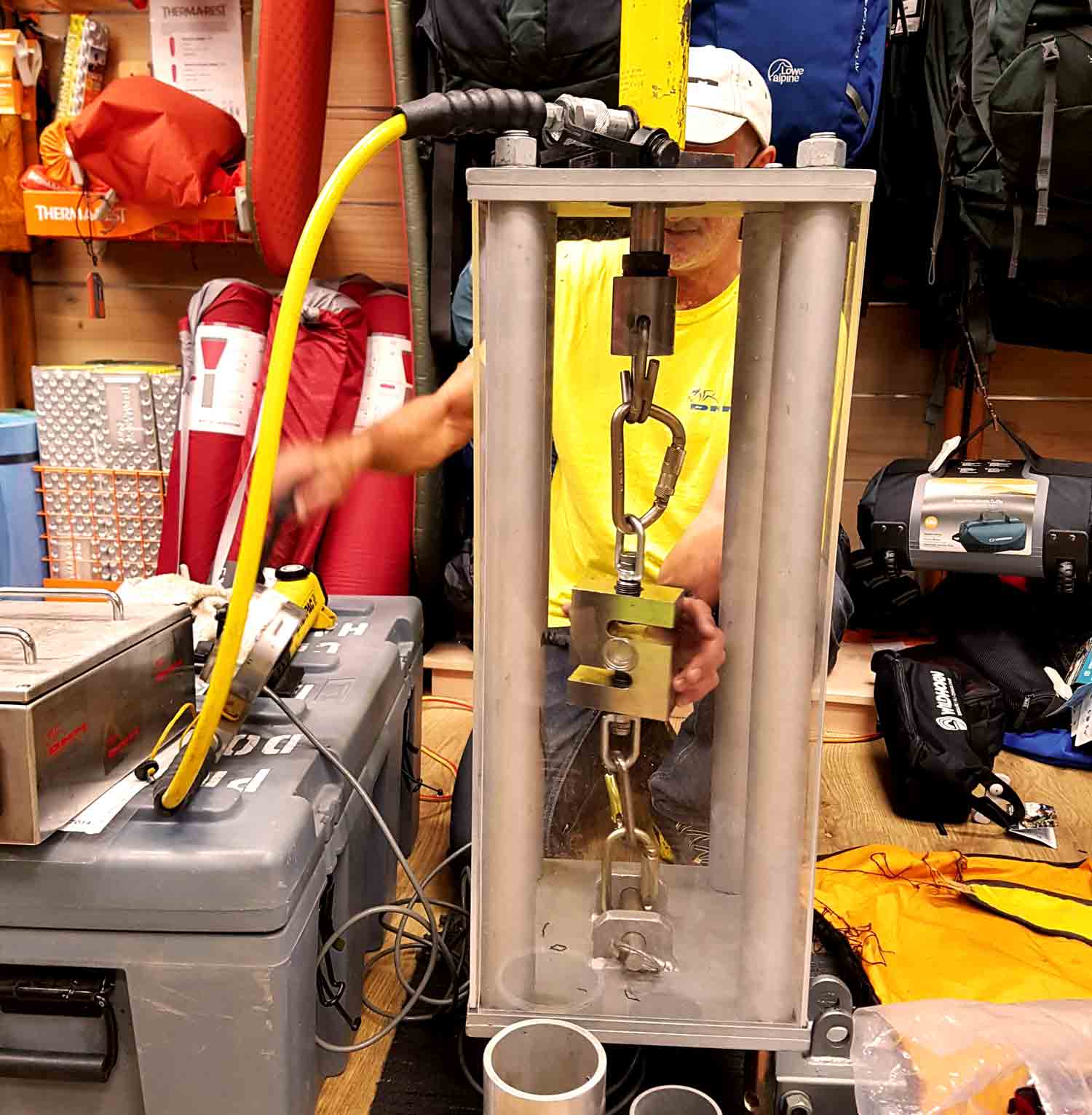DMM DAY! What we learnt by breaking climbing carabiners and slings

Recently we were very privileged to have Chris Rowlands from DMM Wales come and visit us at Mountain Equipment. Not only did he give us some private staff training but he also ran DMM Day in the store! The highlight of which was his portable rig for breaking climbing gear, an awesome little set up which allowed us to break carabiners, slings, harnesses or trad gear to see what it actually fails at. The challenge was put out to customers to bring down their mankiest piece of climbing hardware they have to see where it fails. DMM were also kind enough to replace that old manky, worn-out piece with a brand new one! It was a great day of information and learning about the climbing gear itself, design, manufacturing, the use of why and how it breaks. So what did we find?
We were able to break a heap of gear that day including carabiners, slings, harnesses and more. There was also a huge variation to how worn the gear was as well as its age. It was great to be able to test gear that was old as the hills but hardly used as well as items only a couple years old but has taken a huge beating. So what did we find? Well here's a very unscientific summary of what was discovered:

1. Climbing gear is strong! - When you look at the force which stuff breaks it is quite remarkable. First of all it just simply takes a lot of effort to break. When you think that the human body can roughly withstand around 7 to 8kN of force (maximum) before you start rupturing internal organs, even the worst of the gear tested was breaking at a level that, although at this tipping point, would come through for you in most scenarios.
2. Soft goods (nylon and dyneema) can degrade quite a lot with age, wear and tear and UV damage - Most climbers already know this but it's the soft stuff that needs regular replacing. we had heavily worn slings at 4 years as well as some older ones breaking at around 10kN, which is getting right down there and certainly not worth risking for the sake of a few dollars. However it was pretty easy to visually inspect something to get an idea of how bad it might be. If it looks frayed or worn - good chance it is it is. We did have some older gear (10 years) that had seen hardly any use break only slightly below its manufactured rating. Which did (pleasantly) surprise us a little.
3. Carabiners stay strong - Age seems to have no impact on the strength of a carabiner, rope wear grooves and malfunctioning gates are what weaken them. We were able to test some carabiners that were 35+ years old and they broke perfectly at their 2300kg (kNs hadn't been invented then!) rating. It was the younger, but more worn carabiners that failed below their rating. Perhaps the most integral part of a carabiner is that it is a closed loop. If the gate is not operating 100% and there's a chance of the carabiner being loaded while not completely closed, this is when you run into trouble. The next thing to look at is loss of material or wear spots and corrosion. Inspect them, if they are mechanically sound with no wear spots (loss of material) or are not corroded then they’re amazingly strong. What we also found (and you can't read this sentence without reading point 4) is that even worn carabiners, though weaker, never got down to the dire strengths of some of the worn soft goods, however they may still require changing due to their effect on ropes and slings.
4. Worn carabiners have edges, and edges cut things - When you hear of a climbing accident because of gear failure, 99% of the time it's because their "rope cut". Climbing equipment (even badly worn climbing equipment) rarely breaks because it's "not strong enough", it breaks because metal hardware or the rock cuts soft goods, or the soft goods are so degraded they cut more easily. Even a brand new rope tensioned over a sharp edge can easily cut. So when you're assessing your climbing hardware you want to make sure there are no sharp edges caused by either rope wear or metal on metal scratching. Apart from the worst case scenario of it cutting, the more immediate scenario is that it just wears your brand new rope out quicker.
So what's the conclusion we took away from DMM Day? First of all, climbing gear is strong. We were pleasantly surprised to find that most things tended to break above 10kN despite looking incredibly worn as opposed to anything failing lower than anticipated. The first things to replace are your worn soft goods like nylon and dyneema slings, harnesses etc. Look for wear-and-tear like fluff or colour fading. Luckily most of the things that wear out quicker are also the cheapest things to replace. The next thing to check is your metal hardware. If the gates are mechanically sound and they are not worn with a rope groove or dramatically corroded or scratched, then there's no reason to think they might be weaker. Retire carabiners if you think they could damage ropes or slings with worn edges or if the gate isn't working properly.
We'd like to say a huge thank you to Chris and the guys at DMM, as well as Expedition Equipment for the awesome day. If you have any questions on climbing gear in relation to this, please don't hesitate to drop us a line at web@mountainequipment.com or call is on 02 9264 5888
